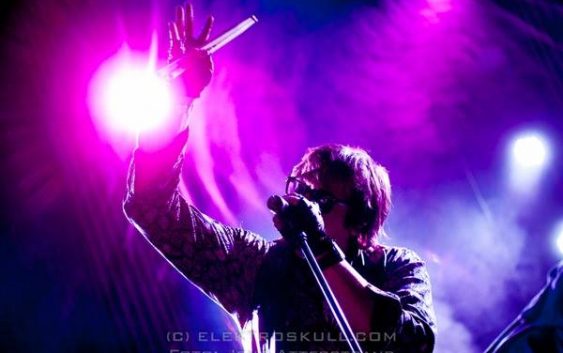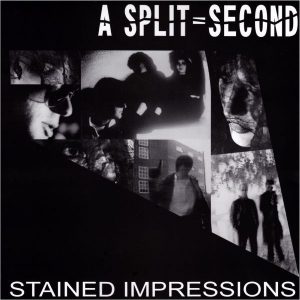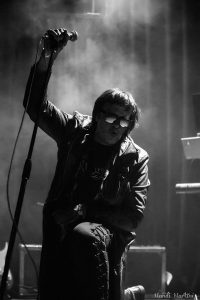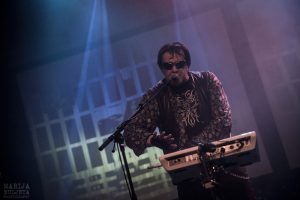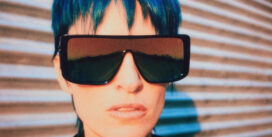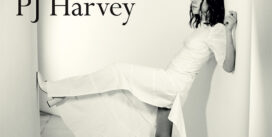After seeing Belgian electronic music legends A Split-Second at BimFest XV in December 2016, I really wanted to chat with Marc Ickx for more than just a few moments that I had then. They gave an excellent show in front of a packed venue and made the festival experience unforgettable. Marc kindly agreed to the interview.
1. Hello, Marc, and thank you for the interview. It has been a long time since your first self-released album Stained Impressions. Although it relied on some new wave influences, it already had the A Split-Second recognisable sound. I didn’t know you were a bass player. How did you move towards electronic sound? Was it the time and the place or your desire to experiment with more electronic music expression?
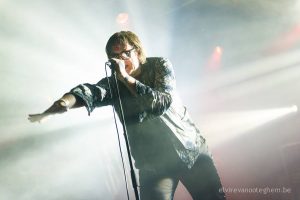 Marc: Originally, I started out as a drummer, but I switched to bass guitar because I also wanted to sing and write songs. The bass was a prominent instrument in all the new wave bands I was into, like Bauhaus, the Cure, Echo and the Bunnymen… Neurobeat was a song I wrote in high-school during that new wave period, and it wound up on Stained Impressions and Ballistic Statues. In the mid-eighties, when MIDI and new sequencers and drum machines revolutionized the possibilities of making music on your own, I wanted to explore this, as I became more influenced by bands like Cabaret Voltaire and Fad Gadget. The options to experiment were infinitely greater with these instruments, so that was definitely one of the reasons to move in that direction.
Marc: Originally, I started out as a drummer, but I switched to bass guitar because I also wanted to sing and write songs. The bass was a prominent instrument in all the new wave bands I was into, like Bauhaus, the Cure, Echo and the Bunnymen… Neurobeat was a song I wrote in high-school during that new wave period, and it wound up on Stained Impressions and Ballistic Statues. In the mid-eighties, when MIDI and new sequencers and drum machines revolutionized the possibilities of making music on your own, I wanted to explore this, as I became more influenced by bands like Cabaret Voltaire and Fad Gadget. The options to experiment were infinitely greater with these instruments, so that was definitely one of the reasons to move in that direction.
2. A Split-Second got immediately noticed after your second album Ballistic Statues. The album featured some of your greatest hits: “Rigor Mortis”, “On Command” and “Flesh”. The “Flesh” single was amazingly received and it got A Split-Second recognised. How do you feel about the track and the New Beat genre story that goes with it?
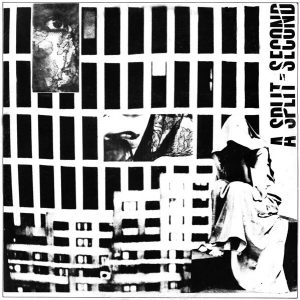 Marc: We felt, and still feel, very proud of the track. We set out to make a certain type of dance song, and got exactly what we wanted. The fact that DJs slowed it down to create New Beat was beyond our control, but it gave the song a double life. It’s fun to see people still arguing which version is the best, but at the time the New Beat-stamp was a problem for us. We were, and are, very much a live band. The New Beat scene consisted mainly of playback performers, sometimes miming songs that weren’t even sung by them. In Belgium, we hardly got any gigs, but instead we were offered to do playbacks in these dance clubs. By this time we were doing live tours in Scandinavia and Spain, and we chose to continue on that path instead of going for the quick buck. In retrospect, it’s great to be mentioned in music encyclopaedias, but the reactions of people at live gigs, or to any of our songs, are what really matters.
Marc: We felt, and still feel, very proud of the track. We set out to make a certain type of dance song, and got exactly what we wanted. The fact that DJs slowed it down to create New Beat was beyond our control, but it gave the song a double life. It’s fun to see people still arguing which version is the best, but at the time the New Beat-stamp was a problem for us. We were, and are, very much a live band. The New Beat scene consisted mainly of playback performers, sometimes miming songs that weren’t even sung by them. In Belgium, we hardly got any gigs, but instead we were offered to do playbacks in these dance clubs. By this time we were doing live tours in Scandinavia and Spain, and we chose to continue on that path instead of going for the quick buck. In retrospect, it’s great to be mentioned in music encyclopaedias, but the reactions of people at live gigs, or to any of our songs, are what really matters.
3. You produced another historical album …From The Inside a year later with hits “Bend My Body Armor”, “The Colosseum Crash”, “Scandinavian Bellydance” and “Mambo Witch”. By that time A Split-Second developed the sound which was very hard to label. What was your inspirational thread at that time?
Marc: At that time, I was writing my Master’s Thesis in psychology, so I was reading avidly and my mind was in overdrive. All my cultural obsessions and the turmoil in my personal life wound up in the lyrics of that album. There wasn’t really a single inspirational tread, but rather a chaotic outburst rooted in all my influences at the time, ranging from Dead Can Dance over Einstürzende Neubauten and Test Department to Monty Python, William Burroughs, René Magritte and countless other writers, painters, styles, bands etc. The sound was just something we were perfecting all the time. We were fans of producers like Trevor Horn, and although we made alternative music, we always wanted to sound at least as good as any of the most expensive bands in the world. So yeah, we were an overly ambitious and arrogant bunch, but it’s always best to aim high, don’t you agree?
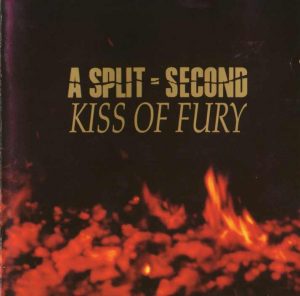 4. It seemed nothing could slow the band down. You released another successful album in 1990, Kiss of Fury. You integrated more guitars on this release. How did you feel about your sound evolution at that time and the evolution of the band itself?
4. It seemed nothing could slow the band down. You released another successful album in 1990, Kiss of Fury. You integrated more guitars on this release. How did you feel about your sound evolution at that time and the evolution of the band itself?
Marc: It’s funny how people seem to think there are more guitars on that album. There are actually only three tracks with guitar on it, just as many as on our first album Ballistic Statues. We used sample guitars on Cold War in the Brainbox as well, but the guitars on this album are just mixed better, I think. Kiss of Fury was our first album where we had a budget to go to a bigger studio with an extra engineer to record the vocals and finalize the mix, which got us on a bigger American label as well. The evolution was more of a technical nature. In terms of style, every song is an individual entity to me. Every track has its own identity and style, and that’s the way we’ve always approached it. Somehow it all ends up sounding like A Split-Second though.
5. During those years, the band toured USA and played numerous shows in Europe. How was that time for you?
Marc: Very hectic and a bit of a blur, but it’s amazing to see people in those different parts of the world connect with your music. The recordings will always be there, but every concert is a unique experience. On long tours you have to be careful to give it all you got each time, and not switch to autopilot, though.
6. People still feel very enthusiastic towards your music. After Vengeance C. O. D., Megabite and Transmix you were idle when it came to new albums. Nevertheless, people are really eager to see you live. Does it make you think that during the 80s and 90s you left a great legacy for the old and new fans?
Marc: I hope so, and we’re very grateful for the reactions. It does make it difficult to release new material though. The old material has such a cult status that it makes you wonder if you can do anything more to live up to those expectations. I am more aware of the position of the band now, and I realize the Megabite album was too big a departure for the classic A Split-Second audience. It appealed to an entirely different audience, that wasn’t into the old stuff, so it should have been released under another name. When we release new stuff, it should fit seamlessly into our current live set.
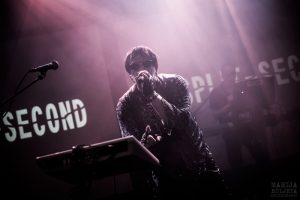 7. BimFest XV live show seemed like a hit parade. How do you choose the set lists for your live shows? What do you think is the key to a successful show?
7. BimFest XV live show seemed like a hit parade. How do you choose the set lists for your live shows? What do you think is the key to a successful show?
Marc: Since we almost always play festivals nowadays, and our timeslot is usually limited, we play a blitzkrieg set and squeeze in as many songs as we can. I’d like to do a set someday where we can fit in different stuff like Kiss Of Fury or From the Inside, songs that work really well live, but don’t fit that format.
For me, the key to a good show is connecting with your audience. That’s why we don’t work with video projection. I figure if you want to watch TV, you can do that at home and listen to the music there. When you work your performance and connect with the audience, something happens that you can’t describe, define, or record on video even. The current line-up with Roel on keyboards and Djuro on guitar has grown into a tight unit by now, and over the past few years, the people at our gigs have been simply amazing. Nothing else comes close to that.
8. You have re-released the first and official tape Stained Impressions on vinyl and CD later on Dirk Iven’s Daft Records. How did this come about?
Marc: As everyone knows, Dirk isn’t only the nicest, but also one of the busiest people in the business. I met him when we released Bodycheck on a cassette compilation entitled Mad In Belgium. He got in touch with me, and he was one of the first people to hear Stained Impressions. He was very supportive at the time. He also convinced me to start performing again in the new millennium, so you have him to blame for that too.
He’s also constantly digging for unreleased material, and a few years ago he proposed to give Stained Impressions the proper release it never got. I hesitated at first, because these have been my very first baby steps in recording and it all sounds a little naïve to me, but the response was great, and I’m glad we did it.
9. Is there a possibility of re-releasing some other albums?
Marc: The masters are currently with Warner Bros Belgium, and they’re not doing anything with them, so I’m getting in touch with a lawyer now to get the rights back. Keep watching this space for more news soon!
10. Speaking of releasing, does Marc Ickx have anything new for us?
Marc: Working on some demos now, but I’m still building my studio, and like I said, the standards are very high, so… We may start with a mini-album as a warm-up to a full album. The title is there, a whole lot of lyrics as well, now it’s time to get the machinery in gear!
11. I only got to see you once, a few months ago, and it was a killer show. Has anything changed with your passion for live performance over the years?
Marc: The intensity is still very much the same. I do miss being able to play a full set sometimes. We did it in NYC, in Sao Paolo and last time at Bodyfest in Stockholm, and it feels much more rewarding to be able to play a full set.
12. Any new live dates?
Marc: WGT Warm-up in Felsenkeller Leipzig on June 1st, and Castle Party in Wroclaw, July 14th. See you there!
13. What are your future plans for A Split-Second?
Marc: Hopefully some re-releases, definitely a new album, and some intense touring next year, if you’ll have us!
14. What is Marc Ickx doing besides A Split-Second? I read somewhere you were involved in film making. Are you still active in that field?
Marc: In the late nineties I was sick of the music business and it felt natural to go back to film making, which was another passion of mine before my music career took off. I worked on a few scripts, made a few soundtracks, which I hadn’t done since the early nineties. I made a few short films, a documentary and eventually I was offered a seventies-style horror feature to direct. It would take way too long to explain all my adventures in that area and there may be more to come, but right now I’m focusing on my studio and new songs.
15. The music industry has undoubtedly changed. How do you feel about the technological changes in making music and the social media era?
Marc: The social media aspect is great, because it’s a lot easier to connect directly with everyone in the business, from promoters to other musicians and the audience, than ever before. In making music, technology is just a tool. Creativity is what gives your music its value. With the means that are available today, you can crap out an album every week if you like. If you don’t want to sound like everybody else though, that takes inspiration and a lot more hard work. It’s great to have all those new toys, but it’s how you use them that determines whether you’re just a sheep in the flock, or the wolf that gets everyone’s attention.
16. What would be your advice for the new bands who are trying to make a break in this tough business today?
Marc: I’m probably the worst business advisor you could find, so I can only talk about the creative part. Stick to your guns, find your own identity and don’t try to cater to a certain audience. Make stuff YOU like, do it your own way, and the people will find you.


